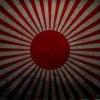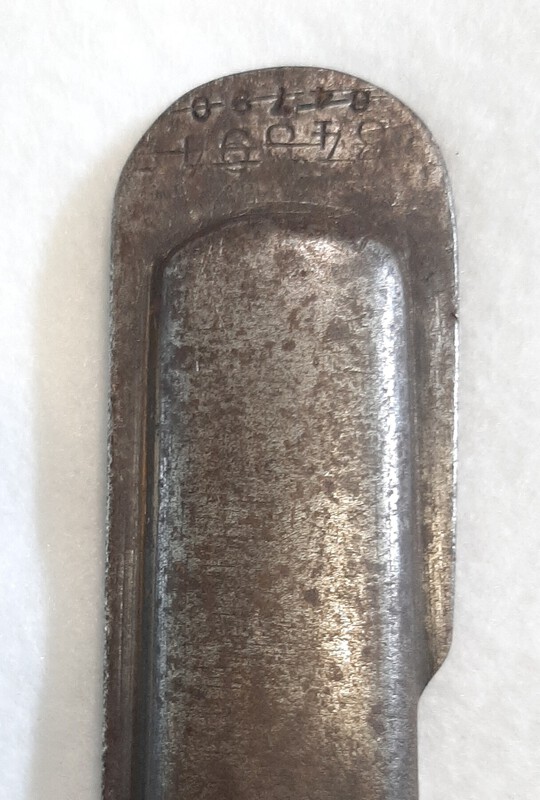-
Posts
1,402 -
Joined
-
Last visited
-
Days Won
12
Content Type
Profiles
Forums
Events
Store
Downloads
Gallery
Everything posted by Shamsy
-
I would guess, Dave, simply a matter of exposed metal rusting and painted metal being protected. Because there is often original paint underneath the 95s and the application quite crude, my suspicion is that it is a crude 'field fix'. Type 32 were never painted, so they should be a neater application of the black paint. Some of my 32, all with leather seppa. Top to bottom: Black paint Light metalic blue Deeper.... blue? In the white These are great swords too. Under rated to collect but very well made and relatively cheap. The stories some of these swords could tell. As we were discussing arsenal refurbishment, I've included a couple of photos of number 3. The saya has undergone re-matching twice before. Just an interesting thing to see.
-
My opinion on black 95 saya being either repainted from an original colour (brown or green) or post war re-painted remains firm, in light of the evidence (and lack of counter evidence). I am remiss to say there have been a few more examples I have not added to the 95 thread. The 32, I would think, are the same. The original swords were clearly 'in the white' and later, some saya were blued or painted. Dawson had a very small sample and also reached that conclusion. That is consistent with refurbishment or field painting. I've never really seen post war black paint on 32s. Probably because books don't list them as 'rare'. I blame the 'rare' reference for all the post war repainted Type 95s. It is something easy to do, that anyone can do and suddenly they have a 'rare' sword to sell for more money. Remember, the key to my theory is that where it is not post war, the black is period, but not original to the saya. Your 32 shows clear signs of patina and age and falls into this category, as opposed to post war fiddling.
-
Thanks Dave for passing on the information about the emblem. An early version of the army sunburnt. A custom kyu-gunto for an army officer then, one who decided to mount a tanto blade (is it actually a tanto or is it a dirk?). I don't recall seeing another kyu with a tanto blade before (again, unless it's a dirk), so very rare. An absolutely lovely and unique item. I've postulated before that my own kai-gunto with the o-tanto blade must have been an important family heirloom. Purely speculative of course, but perhaps the same thing here? Would love to see that nakago and what it can tell us about the blade history and perhaps clarify what it should be rightly classified as.
-
Nothing wrong with careful cleaning and preventing further decay, but other than tidying up the blade with oil and hard work, just let the old girl have a rest in retirement. The Best thing you can do is wear cotton gloves when handling so your own skin doesn't further degrade finish, particularly paint. That's a nice variation of the early Gifu contractors. They tried to maintain a realistic ito wrap by slightly adjusting the front face ito to 'dip' a little. The forward retention screw thus passes through the same diamonds on both sides. Somewhere from rare to uncommon to find the early swords. Gifu are a less common contractor too, so a decent one to start with.
-
Lovely little sword and it looks to me as though it is all original to the piece. I really like these tantos mounted as swords. Rare as hens teeth.
-
I agree. This is a pretty definitive statement that suggests even where an NCO has access to an officer sword, we would not deface both it AND his ISSUED sword (which he did not own) by ripping them apart and jamming them together. The NCO fittings with officer blade myth should be buried deep, lest it become as embedded as the 'pilot gunto' myth or the Type 3 designation. That towards the end of the war NCO could bring there own swords is an undisputed fact though. I would imagine (conjecture only) that these were all civilian mounts though. Impersonating an officer is not a trivial matter. There are some photos too of soldiers/NCO with swords that were not 95s... Pretty sure F&G had one in their books. *Throwing in a disclaimer that I am aware that more than NCO and Commissioned Officer ranks were authorised to carry swords. NCO is just an easier 'catch all' reference.
-
More money than sense. Just lazy not to do the research, but it'll be a lesson they're unlikely to forget quickly.
-
My mantetsu with aluminum saya is 1941, so not pre-40s.
-
Suya Type 95 sword for NCOs. Later example with the Tokyo star stamp and little less common than Kokura stamps. A bit of a rough example though. Mass made, machine made blade which will be unsigned. Nothing to disassemble for and find, so leave it as is. There is a wealth of information about these online, so now you have a model, have a look and see what you can find.
-

Repairing slip found inside of the Copper handle
Shamsy replied to BANGBANGSAN's topic in Military Swords of Japan
My coppers are all rock solid, but yes, I am aware there was some limited effort to modify a few that were returned for maintenance. I added a fair bit of info to a post a few months back about coppers that were returned and had a replacement iron tsuba added along with a second screw. There are a few second screws I consider to be less honest seeming examples, but I think the judgement is a case by case basis. -

Repairing slip found inside of the Copper handle
Shamsy replied to BANGBANGSAN's topic in Military Swords of Japan
That's an absolutely awesome find! Waiting for a full translation if possible. None of mine will ever be disassembled, despite some interesting stamps and apparently documents being found. -
Nice, clean example and a bonus to include the sarute. The early Suya are well made swords and you've got a nice level of patina without being worn out.
-
Off the topic of transaltions and dicussion of the blade, but since there is a generated discussion about the blade and fittings.... We discussed officer blades being jammed into 95 mounts not that long ago and there were plenty of examples shown in the thread (now attached below). My opinion was and remains that these are all put-together swords of various crudeness. I don't put any credence in the idea that some private officer purchases of 95s had blade 'upgraded'. There would be little to no difficulty getting a proper koshirae made for a better blade. Blades were in shortage, not koshirae (other than brass as a material, though this can still be found in abundance on the very latest war representative examples of 98s). The vast differences, quality of fitting, crude workmanship and ugly mix of fittings of these swords screams a post war put-together in all cases I have seen. Some don't have habaki fitted, some show obvious signs of grinding and crude fitment. I cannot believe for a minute any self respecting officer would have chosen to retain any part of the private purchase 95 by choice. Nick has already stated that Rinji swords required a lot of propaganda to 'sell' to proud officers (and these we're proper officer swords), so the private purchase 95s were likely a stop-gap measure, one of necessity, not desire. This likely explains why no photographs (that I am aware of) have ever been found where a commissioned officer is posing with a Type 95. Can I categorically say for sure it never happened? Of course not, but I think the onus rest on those trying to prove the 'theory' rather than the skeptics. Something fitting well means only that someone spent more than an hour making it fit. For those interested, here are a few examples of nice blades in NCO fittings: Here is an example of the reverse, NCO blade fitted in 98 Koshirae:
- 31 replies
-
- 2
-

-
- katana
- restoration
-
(and 1 more)
Tagged with:
-
That's a really nice sword. Thanks for sharing. I'm glad the leather remains. Not pretty but an important part of the swords history. Otherwise it'd just be another unknown providence wak
-
You would do better to ask in the Nihonto section of the board. A search for 'polishing' will also yield results.
-
Absolutely 100% real, no doubt at all. A lot of these later swords have great paint retention. Paint shades and colours vary, no issue. Menuki often are, it's the edges, the way the sword is held, the fact they are raised and (pure conjecture) perhaps the type of paint used. You got a really nice example. Congratulations, don't consider condition a bad thing! I don't think it's repainted at all.
-

Osaka-Kyoto area Rinji Seishiki mounts
Shamsy replied to george trotter's topic in Military Swords of Japan
I've had issues with that seller. -
It certainly has genuine patina, but the materials of the koshirae and style are very unusual. It looks more like an 'island sword' to me. The nakago will be most telling.
-
I've seen them for sale here, but whether they were imported from the U.S. or U.K. first, I don't know.
-
As in for sale, in collections or have I owned one? To answer simply, I've not seen any in other collections (Not that I see many other collections in Australia, though I've seen them for sales a couple of times in auctions here. I've never owned one, not my area of collecting.
-
Certainly looks authentic. Someone will be able to reference Dawson's book, I'm sure he has it listed.
-
Pierre is a great bloke, but I'm not sure why he attributed the sword to Chinese. They had their own sword, but like Trystan said, it may have been captured or purchased. Unlikely to ever know. It's a genuine example of a 32 though, so much better this time around.
-

Importing/Exporting and Customs queries and advice
Shamsy replied to Brian's topic in Swords and Edged Weapons
Just going to add some additional information for exportation of swords from Australia. I had a lot of difficulty sending a sword to the U.S. The Australia Post requirements for packaging are onerous and greatly increase the cost of shipping. However, exportation of sword is allowed to most countries (Aus Post staff can check individual countries for you). This information was sent from Australia Post after a sword was returned: The packaging for sharp-edged or pointed item must comprise: Primary wrapping with the sharp edges or points wrapped in or protected by cork, polyurethane foam or similar material. An outer rigid container of metal, wood, strong plastic or other rigid material. Scabbards do not count as fulfilling these requirements. A Type 95 in a wooden lined, steel scabbard with a steel retaining latch. It is not considered 'safe' to transport. Always get tracking, always pay for insurance, always get signature on delivery. Ask for the yellow 'fragile' tape to be added to the package, for whatever good that does. Longer swords may exceed limits for parcel length (the limit is determined by the length of shipping crates). Some officers are happy to 'make it fit' for you (Basically the just put it diagonally in the crate), but that's on an individual basis. For importation there seems to be no issue with length, but a silly rule for exportation. -
Yeah, not the bolt I hoped for! Peg replacement needed.
-
Looks awfully like a bolt from a 95. What does the nut look like?






